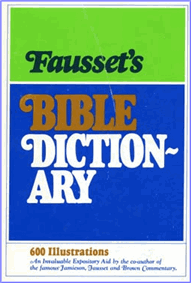Fausset's Bible Dictionary
A B C D E F G H I J K L M N O P Q R S T U V W X Y Z
Mill
In the East two "circular stones" (reechahim), 2 ft. diameter, the lower fixed, and with the upper surface slightly convex, fitting into the upper stone's concavity. This stone has a hole through which the grain passes, above a pivot rising from the lower stone. About the pivot the "upper stone" (recheb, "the rider") is turned by a handle. Being moveable it could be thrown as a missile (Judges 9:53 Gesenius translated "a cut piece of millstone," not a fragment, but the whole with its carefully cut surface; Revelation 18:21).
Two women (Matthew 24:41) facing one another, seated on the ground, both turned it round by the handle, the one supplying the grain through the hole. It was hard servile labor (Exodus 11:5; Judges 16:21; Isaiah 47:1-2; Lamentations 5:18). The mill stones were so essential for preparing food that they were forbidden to be taken in pledge (Deuteronomy 24:6). The cessation of the sound of grinding was a sign of desolation (Jeremiah 25:10; Revelation 18:22; Ecclesiastes 12:3-4, "the grinders cease because they are few ... the sound of the grinding is low".) Larger millstones were turned by asses; Matthew 18:6 "a donkey millstone" (Greek).
Bibliography Information
Fausset, Andrew Robert M.A., D.D., "Definition for 'mill' Fausset's Bible Dictionary".
bible-history.com - Fausset's; 1878.
Copyright Information
© Fausset's Bible Dictionary
Fausset's Bible Dictionary Home
Bible History Online Home
Bible Encyclopedia (ISBE)
Online Bible (KJV)
Naves Topical Bible
Smith's Bible Dictionary
Easton's Bible Dictionary
Schaff's Bible Dictionary
Fausset's Bible Dictionary
Matthew Henry Bible Commentary
Hitchcock's Bible Dictionary

Dr. A.R. Fausset
Popular and Trending:
Meaning and definition of fasting, what is fasting in the bible, fasting definition, why should I fast, the power of prayer and fasting, Location of Galilee, where was galilee in the bible?, fasting definition, Galilee region, cities of Galilee, Sea of Galilee, Definition of biblical fire, what is fire in the bible?, fire and brimstone, fire meaning, baking bread with fire, Definition of the biblical firmament in Genesis, what is the firmament in the bible?, was the firmament the third heaven, firmament meaning, did the firmament bring the flood of Noah?.
